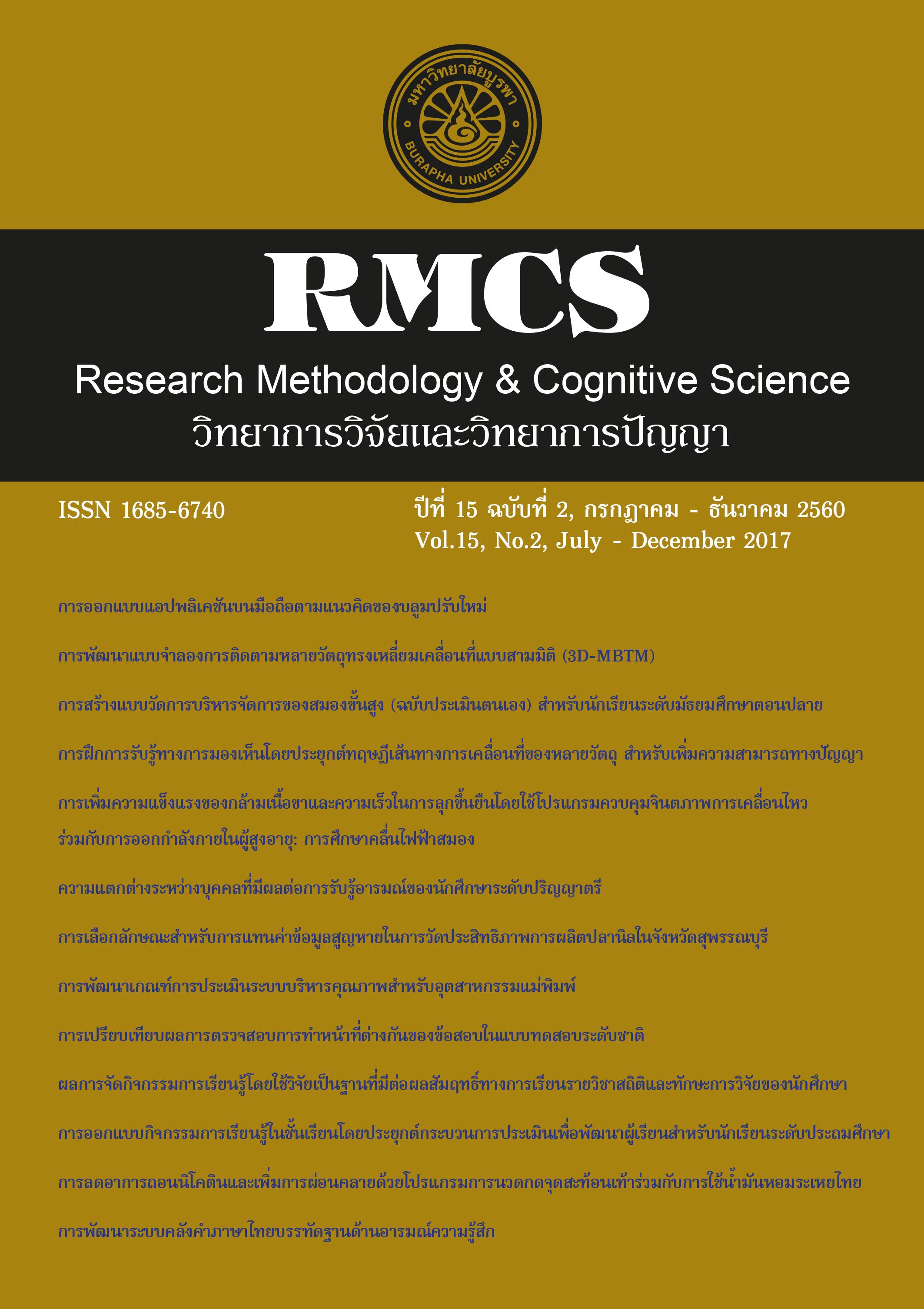Individual Differences Affecting Emotion Perception among Undergraduate Students
Main Article Content
Abstract
Emotion plays an important role in our daily life such as sad, sorrow or happiness depending
on external or internal factors like situations, personality or gender differences. The purpose of this
research was to investigate the relationship between gender, Big Five personalities and emotion
perception. The sample comprised 180 undergraduate students of Burapha University in the
Academic Year 2016. The samples were randomly selected by multi-stage random sampling. The
research instruments were Big-Five Personality Scale, Self-Assessment Manikin Thai Version (SAMThai) Scale, and emotion pictures from Thai Affective Picture Bank System (Thai APBS). Data were
analyzed by descriptive statistics, correlation coeffcient analysis, and multiple regression analysis.
The results were as follows:
1. Male and female of undergraduate students and felds of study had a difference in BigFive Personalities by differing in Agreeableness but there were no any differences in Openness,
Conscientiousness, Extraversion, and Neuroticism.
2. The differences of gender and personalities of undergraduate students had an effect on
emotion perception as follows;
2.1 Gender and Extraversion had an effect on valence.
2.2 Gender, Extraversion, and Conscientiousness had an effect on arousal.
2.3 Gender had an effect on dominance.
Article Details
References
and experimental psychiatry, 43(1), 565-572.
Damasio, A. R. (1994). Decartes Error: Emotion, Reason, and the Human Brain. New York: Harper Collins.
Galea, S., & Lindell, A. K. (2016). Do the Big Five personality traits predict individual differences in the left cheek bias for emotion perception? Laterality:Asymmetries of Body, Brain and Cognition, 21(3),
200-214.
Gard, M. G., & Kring, A. M. (2007). Sex differences in the time course of emotion. Emotion, 7(2), 429-437.
Komulainen, E., Meskanen, K., Lipsanen, J., Lahti, J. M., Jylhä, P., Melartin, T., Wichers., M., Isometsä,E.,Ekelund, J. (2014). The Effect of Personality on Daily Life Emotional Processes. PLoS ONE, 9(10), 1-9.
Kret, M. E., & De Gelder, B. (2012). A review on sex differences in processing Emotional signals. Neuropsychologia, 50(7), 1211-1221.
Lang, P. J., Bradley, M. M., & Cuthbert, B. N. (1999). International affective picture system (IAPS): Instruction manual and affective ratings. The center for research in psychophysiology, University of Florida.
LeDoux, J. E. (2000). Emotion circuits in the brain. Annual Review of Neuroscience, 23(1), 155-184.
Olson, K. R., & Weber, D. A. (2004). Relations between big five traits and fundamental motives. Psychological Reports, 95(3), 795-802.
Rahmani, S., & Lavasani, M. G. (2012). Gender differences in fve factor model of personality and sensation seeking. Procedia-Social and Behavioral Sciences, 46, 2906-2911.
Sabatinelli, D., Flaisch, T., Bradley, M. M., Fitzsimmons, J. R., & Lang, P. J. (2004). Affective picture perception: gender differences in visual cortex? Neuroreport,15(7), 1109-1112.
Sripornngam, T., Chadcham, S., & Sudhasani, S. (2015). Development of the Thai Affective Picture Bank System. Research Methodology & Cognitive Science, 13(2), 57-70.
Tok, S., Koyuncu, M., Dural, S., & Catikkas, F. (2010). Evaluation of International Affective Picture System (IAPS) ratings in an athlete population and its relations to personality. Personality and Individual
Differences, 49(5), 461-466.
Vecchione, M., Alessandri, G., Barbaranelli, C., & Caprara, G. (2012). Gender differences in the Big Five personality development: A longitudinal investigation from late adolescence to emerging
adulthood. Personality and Individual Differences, 53(6), 740–746.
Whittle, S., Yücel, M., Yap, M. B., & Allen, N. B. (2011). Sex differences in the neural correlates of emotion: evidence from neuroimaging. Biological psychology, 87(3), 319-333.
Wongmek, A., Sudhasani, S., & Chadcham, S. (2007). Construction of a Five-Factor Personality Scale for High School Students Using Costa and Mccrae’s ‘OCEAN’ Model. Journal of Educational Research
and Measurement, Burapha University, 5(1), 33-47.
